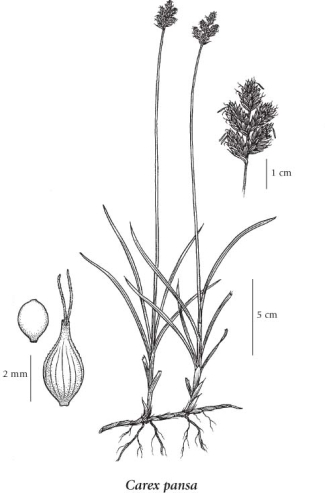Carex pansa L.H. Bailey
sand-dune sedge (sanddune sedge)
Cyperaceae (Sedge family)
Introduction to Vascular Plants
sand-dune sedge (sanddune sedge)
Cyperaceae (Sedge family)
Introduction to Vascular Plants
Species Information
General:
Perennial herb from long, creeping rhizomes; stems 5-30 cm tall, arising singly, longer than the leaves.
Leaves:
Sheaths green, the lower ones bladeless, persisting, darkened; blades 3 to 5 per stem, crowded toward the base, flat or channeled at the base, the margins sometimes in-rolled and roughened, 1-3 mm wide.
Flowers:
Spikes 6 to 15, clustered into an egg-shaped, 1.5- to 2.5-cm long head, indistinguishable, 1-1.2 cm long, unstalked, with both female and male flowers (rarely all female flowers), the few male flowers towards the tips; bracts of the spikes inconspicuous and much like the scales.
Fruits:
Perigynia egg-shaped, 3-4.5 mm long, 1.5-2 mm wide, appressed to ascending, yellowish-brown or brownish-black, biconvex, smooth, few to several nerved below, short-stalked, the beaks bidentate, finely-toothed, about 1 mm long; female scales egg-shaped, as long as and slightly wider than the perigynia, awn-tipped, light to dark brown, the margins translucent; stigmas 2; achenes lens-shaped, smooth, 1.7-2 mm long.
Illustration

If more than one illustration is available for a species (e.g., separate illustrations were provided for two subspecies) then links to the separate images will be provided below. Note that individual subspecies or varietal illustrations are not always available.
Illustration Source: The Illustrated Flora of British Columbia
Ecology
Ecological Framework for Carex pansa
The table below shows the species-specific information calculated from
original data (BEC database) provided by the BC Ministry of Forests and Range.
(Updated August, 2013)
The table below shows the species-specific information calculated from
original data (BEC database) provided by the BC Ministry of Forests and Range.
(Updated August, 2013)
| Site Information |
Value / Class |
||
|
Avg |
Min |
Max |
|
| Elevation
(metres) |
631 | 430 | 800 |
| Slope
Gradient (%) |
5 | 0 | 15 |
|
Aspect (degrees) |
270 | 270 | 270 |
| Soil
Moisture Regime (SMR) [0 - very xeric; 4 - mesic; 8 - hydric] |
7 | 7 | 7 |
| Modal
Nutrient Regime
Class |
B | ||
| #
of field plots species was recorded in: |
3 | ||
| Modal
BEC Zone Class |
BWBS | ||
|
All BEC Zones (# of stations/zone) species was recorded in |
BWBS(1), MH(1), SBS(1) | ||
|
Source:
Klinkenberg 2013
|
|||
Habitat and Range
Sandy beaches, dunes and rocky shores in the lowland zone; rare on the Queen Charlotte Islands, Vancouver Island and Hornby Island; S to CA.Status Information
Synonyms
Synonyms and Alternate Names:
Carex arenicola F. Schmidt
Carex arenicola subsp. pansa (L.H. Bailey) T. Koyama & Calder
